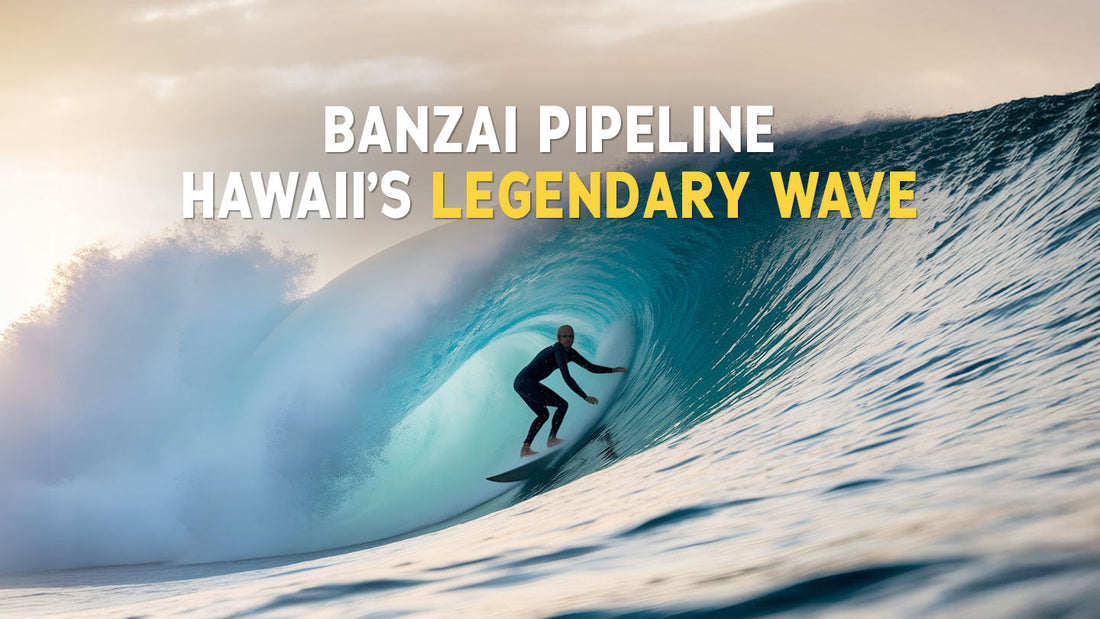
Banzai Pipeline
Share
Few waves globally rival the fame of this spot we're discussing today – a place that represents a break with the rich and evolving Banzai Pipeline history that has shaped modern surfing.
Located on Oʻahu’s North Shore, this legendary North Shore surf break is known for its perfect barrels and deadly reef.
But the story behind Pipeline goes beyond just big waves. It’s a history of discovery, evolution, and fearless surfers who shaped the sport.
Table of Contents
1. The Legacy Behind a Legendary Surf Break
2. The Birth of a Name
3. The History Behind Banzai Pipeline Surfing
4. The Evolution of Hawaiian Surf Culture
5. Understanding the Wave’s Unique Structure
6. The Rise of Pipeline Competitions
7. Safety Tips and Protective Gear for Extreme Waves
8. Insider Travel Tips for North Shore Adventures
9. Conclusion
10. Frequently Asked Question
The Legacy Behind a Legendary Surf Break
The Banzai Pipeline history is filled with moments that shaped modern surfing. From its accidental naming to its rise as the ultimate proving ground, Pipeline has become more than just a wave.
It represents the evolution of the sport and the fearless surfers who push the limits. Over the decades, it has remained a symbol of power, danger, and mastery in the surfing world.
The Birth of a Name
The Banzai Pipeline history begins in the early 1960s. Before that, the wave had no official name. Surfers rode it, but it wasn’t well-documented.
That changed in 1961 when Bruce Brown, a surf filmmaker, was traveling with Phil Edwards and Mike Diffenderfer for the film Surfing Hollow Days (1961).
While filming Edwards riding this powerful break, Diffenderfer noticed a construction project nearby.
Workers were laying underground pipelines along the Kamehameha Highway. Inspired by the sight, he suggested naming the wave Pipeline.
Brown used the name in his film, and it stuck. Soon after, The Chantays’ surf rock hit “Pipeline” further cemented its place in pop culture.
The History Behind Banzai Pipeline Surfing
At first, many surfers avoided Pipeline. The wave was unpredictable and dangerous. It breaks over a shallow coral reef, making wipeouts brutal.
Early surfboards were also long and difficult to control in hollow waves.
Then came Gerry Lopez, known as Mr. Pipeline. In the 1970s, he revolutionized the way Pipeline was ridden. His smooth, fearless style set the standard.
With shorter boards becoming popular, more surfers dared to take on the wave. Pipeline quickly became a proving ground for the best in the world.
The Evolution of Hawaiian Surf Culture
Surfing in Hawaii has deep cultural roots. Known as heʻe nalu, meaning "wave sliding," it was more than just a sport—it was a spiritual and social practice.
Ancient Hawaiians, including royalty (ali’i), rode waves on wooden boards. Surfing held status, and certain breaks were reserved for chiefs and nobility.
During Western colonization, surfing declined due to cultural suppression. However, it made a comeback in the early 20th century, thanks to Hawaiian legends like Duke Kahanamoku.
Today, Pipeline represents the pinnacle of Hawaiian surf culture, where ancient traditions meet modern innovation.
It is the ultimate testing ground, where surfers prove their skills and honor the sport’s deep heritage.
If you're planning a trip to the Hawaiian islands, check out the Best Surf Spots in Hawaii for top surfing locations.
Understanding the Wave’s Unique Structure
Pipeline isn’t just one wave—it’s a dynamic surf break influenced by the interaction between ocean swells, wind conditions, and the reef’s unique formation.
It consists of a series of reefs creating different famous wave breaks, each offering distinct challenges and experiences for surfers.
First Reef
The closest to shore and the most well-known section. This reef produces Pipeline’s signature hollow barrels, breaking with powerful, fast-moving waves that allow skilled surfers to tuck inside the tube.
The wave height here typically ranges from 4 to 12 feet but can grow significantly during major swells.
Second Reef
This reef engages when the swell is over 12 feet, forming bigger, thicker waves with more open barrels.
The added depth here allows for a longer ride but demands strong paddling and wave-reading skills to navigate the more powerful breaks.
Third Reef
The outermost and least commonly surfed section of Pipeline. It activates only during extreme swell conditions, generating massive walls of water that can reach 20 feet or higher.
These waves require immense skill, as they break unpredictably and demand quick reflexes.
Beneath the Surface: Pipeline's Hazardous Reef
The reef itself is sharp and uneven, composed of volcanic rock formations that have eroded into a jagged and dangerous landscape beneath the surface.
Underwater lava spires and cavernous pockets create air bubbles, which contribute to Pipeline’s sudden and forceful wave pitching.
Strong rip currents, unpredictable sections, and sudden closeouts add to the challenge, making expert wave reading a crucial skill in handling extreme surf conditions.
Additionally, the interaction between long-period swells and offshore winds determines how the waves form.
When the right conditions align—typically a west-northwest swell with trade winds—Pipeline delivers its famous, glassy barrels.
However, shifting tides and sand buildup on the reef can alter wave behavior, sometimes making it more unpredictable.
Understanding these complex ocean dynamics for surfers is crucial for anyone attempting to ride Pipeline, as even the most experienced professionals approach this wave with caution.
For additional guidance on staying safe, check out these Water Safety Tips for Surfers.
The Rise of Pipeline Competitions
As surfing progressed, Pipeline became the ultimate test of skill. The Pipeline Masters, first held in 1971, remains one of the most prestigious surf contests.
Over the years, legends like Andy Irons and Kelly Slater have dominated the event, pushing the limits of what’s possible.
Today, competitions like the Volcom Pipe Pro and the Pipeline Bodysurfing Classic continue to celebrate Pipeline’s surf competition legacy.
Each year, thousands of fans gather on the beach to witness the world’s top surfers take on the ultimate wave, turning Pipeline into a spectacle of skill, power, and sheer determination.
Safety Tips and Protective Gear for Extreme Waves
Surfing Pipeline is not for the faint-hearted. Its shallow reef and powerful waves make it one of the world’s most dangerous breaks. Here’s how surfers stay safe:
-
Wear an impact vest: Helps in heavy wipeouts and prevents serious injuries
-
Use a helmet: Protects against head trauma from the reef or other surfers
-
Protect your ears: Use Ear Protection for Surfers such as earplugs or mineral oil-based ear sprays to prevent surfer’s ear, caused by prolonged exposure to cold water and wind
-
Train for breath-holding: Surfers practice breath-hold exercises to prepare for long hold-downs
-
Know your limits: Pipeline is not for beginners. Only experienced surfers should attempt it
-
Have a buddy system: Never surf Pipeline alone. The wave’s power can be unpredictable
-
Understand wave timing: Getting caught inside can be brutal. Knowing when to paddle out is key
-
Use high-performance leashes: They prevent boards from getting lost in heavy surf, but also need to break away in case of dangerous entanglement
-
Study ocean dynamics for surfers: Knowledge of wave formation, currents, and reef structure is key to staying safe in powerful conditions
For an in-depth review of must-have surfing accessories, check out Essential Surf Gear Reviews.
Insider Travel Tips for North Shore Adventures
The North Shore is more than just a surfer’s paradise. It’s a place where nature, culture, and adventure collide.
Whether you're a surf enthusiast or a traveler looking to experience authentic Hawaiian charm, here are some surf travel tips Hawaii visitors should keep in mind:
-
Best time to visit: Winter (November–February) for big waves and major surf competitions, summer (May–September) for calmer waters and better snorkeling conditions
-
Where to eat: Enjoy fresh seafood and island flavors at food trucks like Giovanni’s Shrimp Truck, savor acai bowls at Haleiwa Bowls, and cool off with classic shave ice from Matsumoto’s
-
Outdoor activities: Hike to Waimea Falls for a scenic waterfall swim, snorkel at Shark’s Cove to explore vibrant marine life, or explore the tide pools at Three Tables Beach
-
Avoid peak crowds: Early mornings and weekdays offer a more relaxed experience, especially at popular surf spots like Pipeline and Sunset Beach
-
Respect the locals: The North Shore has a strong community of surfers and residents who take pride in their home. Be courteous, follow surf etiquette, and respect local traditions
-
Parking plan: Many popular spots have limited parking. Arriving early helps secure a spot, and carpooling is recommended to ease congestion
-
Pack your essential surfer gears: A wetsuit or rash guard for protection, reef-safe sunscreen to preserve the ocean, and sturdy sandals for navigating rocky shorelines
-
Check surf conditions: Even if you’re not surfing, understanding the swell forecast can help you plan safer beach outings. Banzai Pipeline’s waves can be powerful and unpredictable, so knowing when and where to swim is key
Whether you’re chasing waves, exploring coastal beauty, or immersing yourself in Hawaiian culture, the North Shore offers an unforgettable experience.
To maximize your surf performance and safety, learn more about How to Use Ear Pro before heading into powerful surf conditions.
Conclusion
The Banzai Pipeline history is still being written. Every winter, new generations of surfers arrive, hoping to make their mark. The break continues to inspire, challenge, and shape the future of surfing.
Few places on Earth capture the essence of surfing like Pipeline. Its legacy is built on innovation, respect, and the fearless spirit of those who dare to ride it.
As long as waves roll in and surfers chase the perfect barrel, Pipeline will remain the heart of the surfing world.
As climate change and human activity affect ocean ecosystems, the environmental impact on surf breaks is becoming a growing concern.
Preserving Pipeline and other world-class waves requires ongoing conservation efforts to protect the reefs and coastal landscapes for future generations of surfers.
Frequently Asked Question
1. What is the history of the famous Pipeline surf break?
The Banzai Pipeline was named in 1961 when surf filmmaker Bruce Brown and surfer Mike Diffenderfer noticed a nearby pipeline construction project. Originally avoided due to its dangerous reef, Pipeline became legendary when surfers like Gerry Lopez mastered its waves, turning it into the ultimate proving ground for elite surfers.
2. How do ocean conditions affect surfing at this break?
Pipeline's waves are shaped by ocean swells, wind conditions, and the reef's structure. The best waves occur with west-northwest swells and offshore trade winds, creating Pipeline’s famous hollow barrels. However, shifting tides and sand buildup can change wave behavior, making conditions unpredictable.
3. Is it safe for surfers to challenge these big waves?
Pipeline is one of the most dangerous surf breaks in the world. The shallow reef, powerful waves, and strong rip currents pose extreme risks. Only experienced surfers should attempt it, using proper safety gear and knowledge of wave dynamics.
4. What gear do experienced surfers use for extreme conditions?
Surfers tackling Banzai Pipeline use impact vests for protection, helmets to prevent head injuries, and ear sprays to guard against surfer’s ear. They also rely on high-performance leashes and specialized shortboards designed for handling steep, hollow waves.

